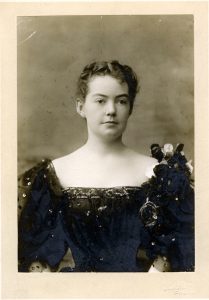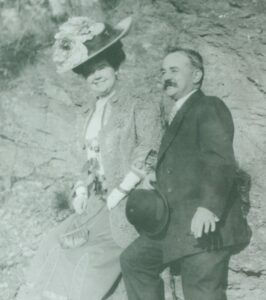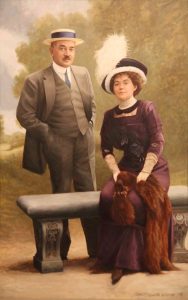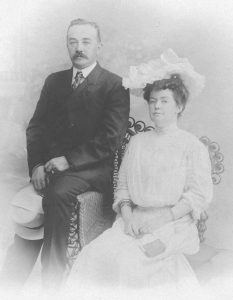Milton and Kitty: A Love Story
Imagine the shock Milton Hershey’s mother must have felt when in 1898 he arrived home in Lancaster from a weekend away with an attractive young bride. Fanny Hershey was not the only person he shocked; the people of the Hershey Caramel Company and Lancaster shared her surprise. To them, Catherine (Kitty) Hershey and Milton had nothing in common, including family background, station in life, or religion. Yet, Kitty mesmerized Milton with her auburn hair, quick laugh, and wit. She needed his stability and he needed her fresh, carefree outlook on life.
 From the start, Milton was generous — Kitty arrived with an elaborate trousseau from Fox Sisters of New York. Called, “one of the most exclusive dress-making establishments in the United States” by The New York Times, the business was so exclusive there was no sign on the door, no advertisements in the newspapers, and no one was accepted to shop unless proper introductions were made. So impressive were Kitty’s dresses and hats, a young neighbor girl remembers trying to catch a glimpse of Kitty through the fence of the yard and thinking Kitty was the “most beautiful lady I had ever seen.” Milton brought his young bride fresh flowers every day and she affectionately called him, “my little Dutchman.” Kitty enjoyed their Lancaster home that featured lovely gardens with parrots on stands and a fountain with a ball kept aloft by the continuous spray.
From the start, Milton was generous — Kitty arrived with an elaborate trousseau from Fox Sisters of New York. Called, “one of the most exclusive dress-making establishments in the United States” by The New York Times, the business was so exclusive there was no sign on the door, no advertisements in the newspapers, and no one was accepted to shop unless proper introductions were made. So impressive were Kitty’s dresses and hats, a young neighbor girl remembers trying to catch a glimpse of Kitty through the fence of the yard and thinking Kitty was the “most beautiful lady I had ever seen.” Milton brought his young bride fresh flowers every day and she affectionately called him, “my little Dutchman.” Kitty enjoyed their Lancaster home that featured lovely gardens with parrots on stands and a fountain with a ball kept aloft by the continuous spray.
While Milton was perfecting his milk chocolate formula at The Homestead, Kitty visited him, watched the experiments, walked about the farm, and chatted with the girls in the kitchen. When Milton and Kitty moved to The Homestead while their home, High Point Mansion was being built, Kitty kept busy by creating the same lovely gardens she enjoyed in Lancaster.
After building and decorating High Point Mansion, both Kitty and Milton spent a great deal of time and attention planning the Hershey Industrial School. Milton worked with Attorney John Snyder and Superintendant George Copenhaver and Kitty collaborated with Prudence Copenhaver about the daily life of the School. The Hersheys were adamant that their creation be both a home and school and the students live in a nurturing environment. Milton credited the vision for the School to be Kitty’s idea and commented in a 1923 New York Times article, “My wife and I decided that we ought to do this…It was hers and mine.”
 Evidence of Milton’s love for his wife can be found on their trips abroad. When it was apparent that she suffered from a chronic illness, he took her to healing springs in Arkansas, Colorado, New England, and Europe. They traveled for months at a time and spent a great deal of time along the coast of France, where Kitty basked in the sunshine and sea breeze. Carrying on his tradition of daily flowers for his wife, he hand-picked blooms from shops in the places they visited. When in Nice during the Carnival celebrations, Milton entered the “Battle of the Flowers” parade. No expense was spared to decorate a carriage for the competition with flowers. Kitty’s friend and traveling companion, Ruth Hershey was chosen to ride in the carriage and threw bunches of violets to the onlookers. The attractive American created quite a sensation and the Hershey carriage won the fifth prize.
Evidence of Milton’s love for his wife can be found on their trips abroad. When it was apparent that she suffered from a chronic illness, he took her to healing springs in Arkansas, Colorado, New England, and Europe. They traveled for months at a time and spent a great deal of time along the coast of France, where Kitty basked in the sunshine and sea breeze. Carrying on his tradition of daily flowers for his wife, he hand-picked blooms from shops in the places they visited. When in Nice during the Carnival celebrations, Milton entered the “Battle of the Flowers” parade. No expense was spared to decorate a carriage for the competition with flowers. Kitty’s friend and traveling companion, Ruth Hershey was chosen to ride in the carriage and threw bunches of violets to the onlookers. The attractive American created quite a sensation and the Hershey carriage won the fifth prize.
While at home, Milton acquiesced to his wife’s wishes for the gardens at High Point and gave her generous gifts of furs and jewelry. John Wickersham, a contractor responsible for constructing the factory and other buildings in town, dined at High Point and remembers how Mr. Hershey doted on his wife and his impression that Milton, “was very much in love with Mrs. Hershey and he was giving her every possible care and attention.” When Kitty came down to dinner, Milton went to meet her to, “help her into the drawing room and help her into the dining room and help her into her chair and wait on her and take care of her…it was so obvious his affection for her at the time when I knew him.”
Both Milton and Kitty put on brave fronts, but her illness cast a shadow on their lives. When Milton observed Kitty struggling to use a knife and fork at dinner for the first time, tears were seen rolling down his cheeks. Kitty’s spirit was not dampened by her illness and she bravely lived life to the fullest. Perhaps the greatest illustration of her love for Milton throughout her life is seen at the end. While gravely ill in Philadelphia, Milton arrived at her side and asked if there was anything he could do for her. She requested a glass of champagne and he went out to fulfill her wish. When he returned, Kitty was gone. Although he was grief-stricken, one could believe that by sending Milton on the errand, Kitty spared her beloved husband from saying a final good-bye. Without his wife by his side, Milton Hershey devoted his life and the bulk of his fortune to the Hershey Industrial School. In a 1924 article in McClures magazine, he explained, “Now I am more interested than ever in maintaining and improving the morale and efficiency of all my companies. I want to devote the rest of my life to that end, for the school.”
Throughout his life, Milton Hershey remembered Kitty as the brave, young girl who taught him to laugh. He moved her rose gardens to the Hershey Gardens, and in his later years had his nurse and chauffeur drive him to the gardens to spend time with Kitty’s roses.
— Stories about Milton and Catherine Hershey are from interviews recorded by Dr. Paul A.W. Wallace for Milton Hershey School in the 1950s.



